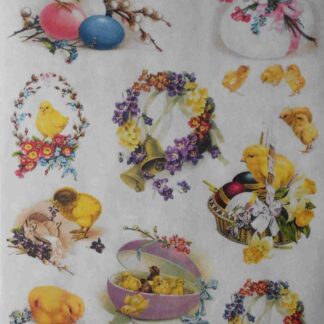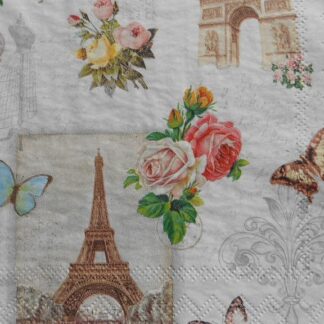Using decoupage rice paper or napkins for decoupage can yield different results, and the choice between the two depends on personal preference, the nature of the project, and the desired outcome. Here’s a comparison and some tips for beginners.
Decoupage essentials: Exploring and comparing rice paper and napkins for crafting masterpieces
Rice paper
Material: Decoupage rice paper is specifically designed for decoupage projects. Rice paper is thin, lightweight, and translucent, making it ideal for achieving delicate and seamless decoupage finishes. They are made from rice straw or other plant fibers. It has a delicate texture with some fibers seen through, and is commonly used in art and crafts.
Advantages:
- Rice paper is easier to handle, it is thicker and more durable and less prone to tearing than napkins, making them ideal for beginners.
- Rice paper is versatile and can be torn or cut to create custom shapes and designs.
- It is easy to glue rice paper to surfaces with decoupage glue or medium, resulting in smooth and professional-looking finishes.
- Its translucency allows for interesting layering effects, where underlying colors or textures can show through.
- Decoupage rice paper comes in a wide range of designs and patterns, offering endless possibilities for creative expression.
Tips:
- Before applying rice paper, gently moisten it with water to soften it and improve its flexibility.
- Use a soft brush or sponge to smooth out the rice paper onto the surface, starting from the center and working outward to remove any air bubbles.
- Seal the rice paper with decoupage glue or medium to protect it and create a durable finish.
Decoupage napkins
Material: Decoupage napkins are very thin and lightweight. Paper napkins serve as versatile canvases for creating intricate and personalized decoupage art pieces, even though these napkins with elegant or festive designs are made to add a touch of charm to a table setting.
Advantages:
- Paper napkins are highly flexible and conforms well to curved or uneven surfaces, making it suitable for complex shapes and textures.
- Decoupage napkins are cheaper comparing to rice paper, and usually you get four identical images on one sheet.
- The images can be torn, cut or separated using very fine wet brush to easy create custom shapes and designs.
- They offer a wide selection of intricate designs and motifs, allowing for detailed and visually appealing decoupage projects.
Challenges:
- Decoupage napkins can be more delicate and prone to tearing comparing to rice paper, requiring careful handling during application.
- It may require extra care to prevent wrinkles or air bubbles when adhering to surfaces.
Tips:
- Napkins have multiple layers, and it’s essential to separate the printed layer from any plain or adhesive layers before use.
- Tear, use sharp scissors or wet brush to cut out the desired design from the napkin, removing any excess layers.
- Apply a thin layer of decoupage glue or medium to the surface before placing the napkin to help prevent wrinkles and ensure adhesion.
- Gently smooth out the napkin with a soft brush or sponge, working from the center outward to eliminate air bubbles.
From rice paper to napkins: Understanding the choices
- Choose rice paper for projects where you want a delicate and translucent effect, such as glassware or candle holders.
- Rice paper is easy to work with for larger surfaces like furniture or trays.
- Go for napkins when you desire a wide selection of intricate designs and patterns, allowing for endless possibilities in crafting unique and personalized decorations.
Unveiling the art of decoupage: General tips for beginners
- Consider the Surface: Rice paper may be better suited for irregular or textured surfaces, while napkins are ideal for flat or gently curved surfaces.
- Preparation is Key: Prepare your surface by cleaning and priming it as needed before applying the rice paper or napkin. This ensures better adhesion and a smoother finish.
- Use Decoupage Medium: Apply a decoupage medium (such as Mod Podge) to both the surface and the back of the rice paper (but surface and on top for napkin) to adhere it securely. Work carefully to smooth out any wrinkles or air bubbles.
- Layering Techniques: Experiment with layering techniques using rice paper and napkins to create depth and visual interest in your decoupage projects. You can achieve different effects by layering translucent rice paper over opaque napkins or vice versa.
- Practice Patience: Decoupage requires patience and precision, especially when working with delicate materials like decoupage papers. Take your time, work in small sections, and allow each layer to dry thoroughly before proceeding.
Ultimately, whether you choose rice paper or napkins for your decoupage projects depends on your personal preferences, the complexity of the project, and the effect you wish to achieve. Experiment with both materials to discover which works best for your style and techniques.
-
 Easter wreath bell chicken eggs rice paper for decoupage
Easter wreath bell chicken eggs rice paper for decoupage -
 Easter wreath 3 eggs decoupage paper napkins
Easter wreath 3 eggs decoupage paper napkins -
 Pale pink vintage roses paper napkins for decoupage
Pale pink vintage roses paper napkins for decoupage -
 Pink roses on green decoupage paper napkins
Pink roses on green decoupage paper napkins -
 Geese couple in winter decoupage paper napkins
Geese couple in winter decoupage paper napkins -
 Green parrot decoupage paper napkins
Green parrot decoupage paper napkins -
 Vintage pink peony decoupage napkins
Vintage pink peony decoupage napkins -
 Paris monuments blue butterfly roses decoupage napkins
Paris monuments blue butterfly roses decoupage napkins -
 Pink and red roses decoupage paper napkins
Pink and red roses decoupage paper napkins -
 Pink shoe decoupage paper napkins
Pink shoe decoupage paper napkins










